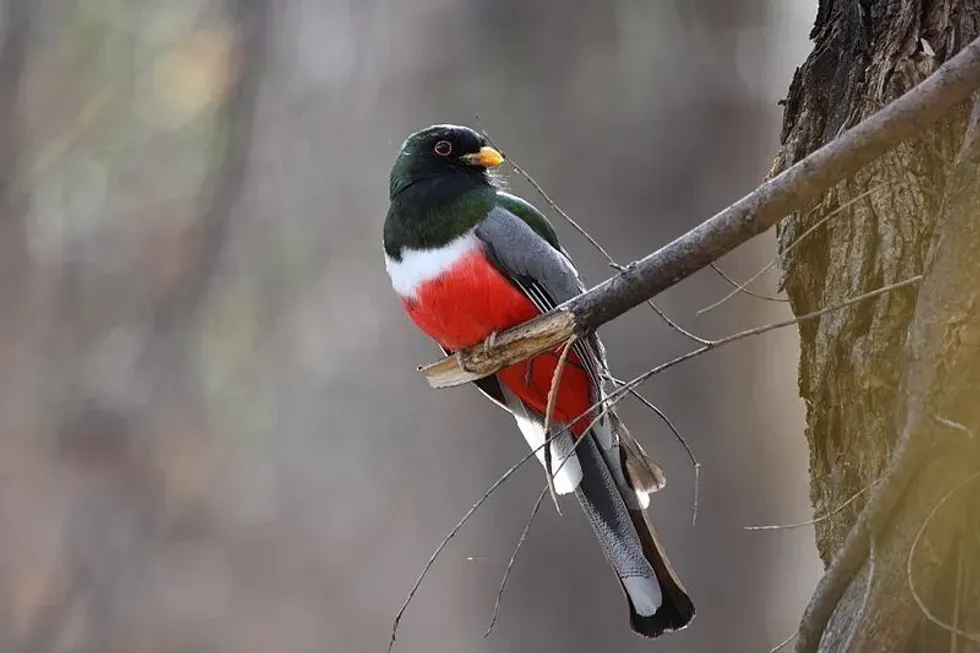The elegant trogon is a near-passerine bird that belongs to the Trogon family. The word 'trogon' is derived from the Greek word that means 'gnawer' as these birds have a diet that comprises insects, along with a hooked bill through which they catch these insects.
These birds were first discovered in the Huachuca Mountains of Arizona in 1885. Almost 50 years later, more nests were found in the mountain ranges and canyons of Arizona. Some of these birds carry out long-distance migration while some do not.
The elegant trogon has five subspecies, namely the Trogon elegans ambiguus, Trogon elegans elegans, Trogon elegans canescens, Trogon elegans goldmani, and Trogon elegans lubricus. They were also previously known as 'coppery-tailed trogon' birds.
These birds are quite rarely found in the United States of America and researchers have warned that they may face severe population decline without appropriate conservation efforts. Accordingly, some conservation efforts have been started in south Arizona.
Read on to know more about these birds. If you liked this article about elegant trogons, then also check out the other articles with amazing facts about the dusky grouse and the sedge wren.
Elegant Trogon Interesting Facts
What type of animal is an elegant trogon?
An elegant trogon (Trogon elegans) is a type of bird belonging to the Trogonidae family.
What class of animal does an elegant trogon belong to?
The elegant trogon (Trogon elegans) belongs to the Aves class of animals, the order Trogoniformes, the family Trogonidae, and the genus Trogon.
How many elegant trogons are there in the world?
There is not much information about the population of this bird species. However, according to the results of some scientific studies by Partners in Flight, it is estimated that around 200,000 breeding elegant trogons are in the world currently.
Where does an elegant trogon live?
The range of elegant trogons extends from the upper Gila River in Arizona to New Mexico in the south. This bird is also a resident of Guatemala in Central America.
What is an elegant trogon's habitat?
Elegant trogons can be found in a variety of habitats which range from lowlands, floodplains, woodlands, and coniferous forests as well as arid scrublands. In Arizona, elegant trogons are found in mountain canyons among the sycamore, pine, and oak tree forests.
In Mexico and Central American regions, they live in an arid lowland habitat. Elegant trogons usually perch on oak, pine, or sycamore trees in their habitat and look for nesting sites.
Who do elegant trogons live with?
Not much is known about the social organization of elegant trogons but the birds have been seen to create nesting sites within their geographical range during the breeding season. Males and females of this species live together in their nests to give birth to the young.
How long does an elegant trogon live?
On average, the lifespan of elegant trogons is about four years.
How do they reproduce?
The elegant trogon male marks its nesting territory during the spring season through its unique call. The males invite the females into their nesting site and the females enter to show acceptance.
The nests are usually found in the hollows of a tree such as a sycamore tree.
The female bird lays two to three, and sometimes even four, eggs which are then incubated by both parents for three weeks. The young are looked after and fed by the parent elegant trogons for a few weeks before leaving the nesting site.
What is their conservation status?
The International Union for Conservation of Nature (IUCN) has listed the elegant trogon as Least Concern. This is because the population of this North American bird is quite stable and shows no sign of immediate decline. However, conservation efforts are important to maintain the population of these North American resident birds.
Elegant Trogon Fun Facts
What do elegant trogons look like?
Males of this species have a dark green or deep green colored head, back, upper breast, and other upperparts while their face and throat are black. They have red underparts as their lower breast and belly are red to orange in color.
Females have a brown-colored head, upperparts, and back. They have a small white mark behind their eye. Both males and females have prominent yellow bills with red underparts along with a white horizontal stripe along their upper parts and belly.
How cute are they?
These North American birds are extremely cute due to the combination of colors on their body. The green-colored head of the males and brown-colored head of the females both have a metallic sheen to them which makes them even more striking.
How do they communicate?
Elegant trogon birds perch on trees in a motionless, silent manner as they only use their necks to see around them. They make a repetitive call that sounds like 'kwah'.
How big is an elegant trogon?
The average length of elegant trogon birds is approximately between 11-12 in (28-30 cm). A giant otter is almost 10 times the size of an elegant trogon because it can grow up to 6.5 ft (2 m) in size!
How fast can an elegant trogon fly?
Although the exact speed of elegant trogon birds during flight has not been recorded yet, they are known to erupt into flight quite fast when they see prey nearby.
How much does an elegant trogon weigh?
The average weight of elegant trogon birds is approximately 2.1-2.8 oz (60-78.6 g).
What are the male and female names of the species?
Male and female birds of the species have no specific names, but as male birds are called cocks and female birds are called hens, male and female elegant trogons would also be called the same.
What would you call a baby elegant trogon?
There is no separate, unique name for a baby elegant trogon so they are usually referred to as nestlings or chicks.
What do they eat?
The diet of these birds usually consists of a wide variety of insects such as cicadas, katydids, and caterpillars as well as small lizards. These birds also eat small fruits and berries during the summer and fall seasons as a part of their diet.
They perch on trees and once they spot insects or fruits on a tree branch, they fly and hover over the insects or fruits and pluck them.
Are they poisonous?
The elegant trogon species is not known to be poisonous or toxic to human beings in any way.
Would they make a good pet?
The elegant trogon would not make a good pet bird as it is essentially a wild North American bird species that prefers its habitat in the forests.
Did you know...
Elegant trogons are 'secondary cavity nester' birds, meaning that they cannot build their own nest so they form their nesting site in the cavities or holes of tree trunks. These holes in the trees are often created by woodpecker birds.
The elegant trogon species can see clearly in low light without difficulty. Just like owls, these birds can also turn their heads 360 degrees!
What is the range map of the elegant trogon?
The range map of elegant trogons extends over the southern part of North America. Four mountain ranges in Arizona in North America: the Atascosas, Chiricahuas, Huahucas, and Santa Ritas are places where they are found to be breeding regularly.
Their northern range starts from the canyons in Arizona and New Mexico to Guatemala in the south. During migration, some birds may extend their range to South Central America in northeastern Mexico or the lower Rio Grande in Texas.
Is the elegant trogon found in Madera Canyon?
These North American birds can be spotted in Madera Canyon in southeastern Arizona. To spot an elegant trogon in Arizona in the wild, it is best to wake up before the sun rises, hike up the nearest hill range, and patiently look at the trees.
These birds are mostly found to perch on an oak or pine tree silently. A skilled bird watcher and resident of Arizona can also identify the bird through its distinct call.
Here at Kidadl, we have carefully created lots of interesting family-friendly animal facts for everyone to discover! Learn more about some other birds from our quetzal facts and barn owl facts pages.
You can even occupy yourself at home by coloring in one of our free printable elegant trogon coloring pages.










